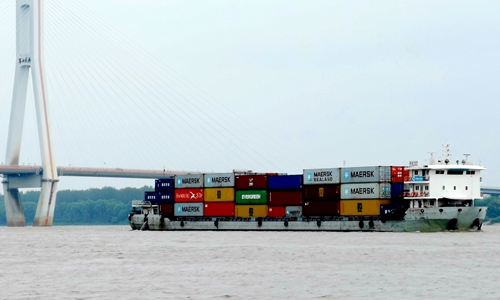
Cargo ships pass through the Wuhan Junshan Yangtze River Bridge, Central China’s Hubei Province. (Photo: IC)
China's yuan-denominated exports increased 8.2 percent year-on-year to 1.41 trillion yuan ($199 billion) in April, beating market expectations of double-digit negative growth.
Imports were recorded at 1.09 trillion yuan, down 10.2 percent on a yearly basis, according to data released by the General Administration of Customs (GAC) on Thursday.
In terms of the US dollar, China's April exports recorded a 3.5 percent increase from a year ago, while imports were down 14.2 percent.
Economists polled by Reuters had expected exports from China to fall 15.7 percent in April from a year ago, and imports were projected to shrink 11.2 percent over the same period. That would have been the sharpest drop since July 2016.
The trade surplus for April was $45.34 billion, compared with $19.9 billion in March.
Foreign trade in the month of April showed a slight drop of 0.7 percentyear-on-year to 2.5 trillion yuan, releasing signs of recovery from the 6.4 percent dip in the first quarter as the world's second-largest economy gradually recovers from the COVID-19 pandemic.
In March, the plunge in China's imports and exports had eased from the January-February period as exporters rushed to clear a backlog of orders which could not be shipped on time due to production shutdowns.
In the first two months of 2020, China's exports contracted 17.2 percent year-on-year and imports fell 4 percent as the coronavirus outbreak battered the country's economic activities.
Liu Xuezhi, a senior economist at the Bank of Communications, told the Global Times on Thursday that the unexpected growth in exports is mainly due to a continuous clearing of orders. Additionally, China's exports of medical supplies to aid other countries and regions combat the COVID-19 pandemic are also surging.
Wang Jun, chief economist at Zhongyuan Bank, said the jump in April's export data is quite unexpected, indicating overseas demand for Chinese products remains strong despite the COVID-19 impact, while the slump in imports shows domestic demand has yet to recover and needs further stimulus.
"China's import and export volumes are polarized," Sang Baichuan, director of the Institute of International Business at the University of International Business and Economics, told the Global Times on Thursday.
Chinese companies have accelerated exports, while foreign companies have stopped production and there are serious shortages of personal protective equipment and fast-moving consumer goods, said Sang.
However, Liu warned "the optimistic data in April will not be sustainable as the COVID-19 pandemic continues to batter global demand and disrupt manufacturing supply chains.
As the COVID-19 pandemic outlook remains serious globally, having claimed more than 260,000 lives, with the highest death toll in the US, many countries have implemented lockdown measures to contain the spread. As a result, supply chains and consumption demand have been impaired.
The Institute for Supply Management (ISM) Purchasing Managers' Index (PMI) for the US last month fell to 41.5 from 49.1 in March, its lowest figure since April 2009.
China's official manufacturing PMI eased to 50.8 for the month of April, as compared to 52.0 in March.
"The expectation of negative export growth for 2020 still exists," said Liu.
China's foreign trade is now facing unprecedented challenges due to insufficient external demand and rising uncertainties, said Gao Feng, spokesperson for the Ministry of Commerce (MOFCOM), during a regular briefing on April 30.
The impact of the pandemic on China's foreign trade is mainly on the demand side, Gao said.
According to a MOFCOM survey of key places, industries and enterprises, current difficulties faced by foreign trade companies are largely cancellations or extensions of on-hand orders, increased risks of rejection and declines in payment, reductions in new orders, impact on supply chains, obstruction of international logistics and mounting funding pressures.


